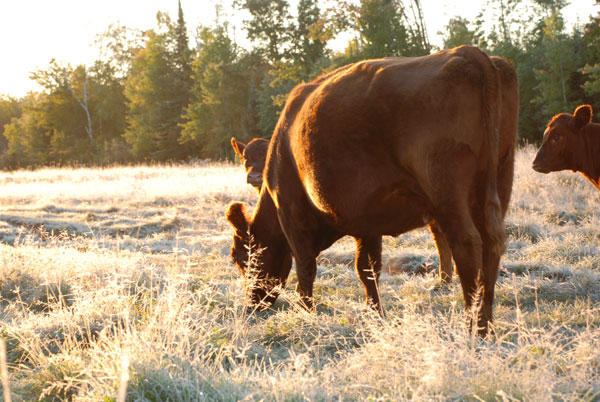Is grazing winter pastures cost-effective, even with supplementation? Here’s what the research found.
September 15, 2016

Is utilizing stockpiled perennial forages in a grazing system beneficial, versus harvesting and taking bales back to the cows to feed them? There are costs in both systems; there’s the cost of harvesting and transportation for bales, versus the cost of supplementation when cattle graze stockpiled forage later in winter.
To find out, Bart Lardner, Western Beef Development Center, University of Saskatchewan, compared the two systems—grazing stockpiled pastures versus bale feeding similar quality forage in a drylot.
“We stockpiled a mixed perennial forage (80% meadow bromegrass, 20% alfalfa), windrowed so we could measure dry matter intake. The other system was harvesting the forage and putting it into round bales—feeding in a pen. We monitored variables, such as change in body weight, change in fat reserves, calving season data, to see if there was any effect on reproductive efficiency,” says Lardner.
Lardner and his team of researchers also monitored forage biomass and quality in the three-year study, looking at legume versus grass component, soil nutrient profile, and economics.

70+ photos showcasing all types of cattle nutrition
Readers share their favorite photos of cattle grazing or steers bellied up to the feedbunk. See reader favorite nutrition photos here.
“Overall, we found forage quality very similar between the two systems. The protein level was between 8% and 9%, the energy level was 56% to 58% TDN. This was more than enough to meet the energy requirements of a gestating beef cow. We found no shift in percent legume and grass whether we grazed it out in the field or harvested it over the three-year period as a round bale,” he says.
“Utilization of available feed was a bit different (putting the cow in front of the feed versus putting the feed in front of the cow). We found greater utilization in the drylot system because feed was in a round bale feeder, versus out in a windrow. The negative effect in the field was due to snow accumulation, making some of the feed less accessible,” explains Lardner.
“In other work, we find that nutrients from urine and feces, and nutrients from the residual feed, is beneficial to the subsequent crop the next growing season,” Lardner also explains. This is where you want those nutrients (in the field) rather than in a drylot where you have to haul the manure out to the fields. Having cows spread manure themselves is a huge benefit that can be difficult to measure.
“We’ve found that grazing— utilizing stockpiled perennial forages —or any type of wintering system that has them out in the field captures more of the urine, nitrogen, etc. to boost future productivity of that field,” Lardner says. This reduces need for commercial fertilizer, and saves the cost of loading and hauling manure.
In the two systems, cows performed similarly. “Though we had to step in with extra supplement in the grazing paddocks, savings in manure hauling made up for the extra cost. Over the three years, we saw a 15% to 20% lower cost in grazing stockpiled perennial forage in fields, compared to feeding the same quality hay in the drylot,” he says.
“We monitored quality of forage from the start of grazing to when we had to end it because of weather. There was a drop in protein and energy in the field, whereas hay quality was static. Pasture forage started at 8% or 9% protein and dropped to about 6%. We had to supplement cows in colder weather—partly because of increased demands due to cold weather and wind chill and partly because of lower protein content of feed by then, but we were well into December or early January,” says Lardner.
“If a person can get 60 to 90 days of grazing (or longer) on stockpiled perennial forage, this is a big factor in reducing costs. If you stockpile it and can’t get at it because of deep early snow, you can come back to it in the spring,” he says.
Heather Smith Thomas is a rancher and freelance writer based in Salmon, Idaho.
You might also like:
Young ranchers, listen up: 8 tips from an old-timer on how to succeed in ranching
13 utility tractors that will boost efficiency in 2016
Burke Teichert: How to cull the right cow without keeping records
3 weaning methods compared; Which one rises to the top?
6 tips for proper electric fence grounding
9 things to include in your ag lease (that you better have in writing!)
You May Also Like



